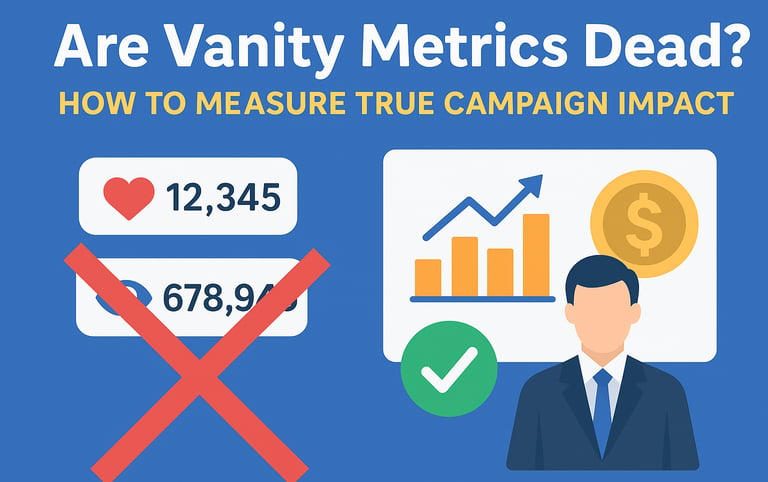Are Vanity Metrics Dead? How to Measure True Campaign Impact
Vanity metrics aren’t dead—they’re just supporting signals. In 2025, true campaign impact is measured by outcome-driven KPIs like pipeline growth, revenue, and customer value, not just likes or impressions.
9/25/20253 min read


Are Vanity Metrics Dead? How to Measure True Campaign Impact
Introduction: Beyond the Like Button
For years, marketers have celebrated “big numbers” — likes, shares, impressions, and follower counts — as signs of success. These vanity metrics looked impressive in reports but often failed to reflect real business growth.
In 2025, as marketing budgets face tighter scrutiny, one question keeps surfacing: Are vanity metrics dead?
Not quite — but their role has evolved. Today, meaningful marketing impact is defined by business-aligned KPIs that connect campaigns to tangible outcomes like pipeline growth, customer retention, and revenue
1. What Exactly Are Vanity Metrics?
Vanity metrics are numbers that look good but rarely drive actionable insight or business results.
Common examples:
Social Media: Likes, follower counts, basic reach
Website Analytics: Page views without engagement depth
Email Campaigns: Open rates without click-through or conversion context
Why they’re problematic:
They lack business alignment — 100k followers ≠ paying customers
They can be easily inflated — ads can drive views, not intent
They promote short-term vanity over long-term growth
2. Why Vanity Metrics Still Matter (in Context)
Declaring vanity metrics “dead” oversimplifies the truth. While they’re not success indicators, they still serve a diagnostic purpose.
Top-of-Funnel Reach: Impressions show whether campaigns are reaching enough people.
Creative Testing: Engagement rates indicate if content resonates emotionally.
Early Trend Detection: Spikes in shares or mentions can flag emerging interest.
Think of vanity metrics like vital signs — they don’t tell the full health story, but they help marketers know where to look deeper
3. The Shift: From Surface Metrics to Business KPIs
Modern marketing measurement is outcome-driven. The focus has shifted from visibility to value — metrics that link directly to growth and performance.
Key performance indicators now include:
Revenue Impact: Customer Acquisition Cost (CAC), Return on Ad Spend (ROAS), Marketing-Attributed Revenue
Pipeline Growth: MQLs, SQLs, and Sales Accepted Leads
Customer Value: Lifetime Value (LTV), Retention, Net Promoter Score (NPS)
Engagement Depth: Conversion rates, session duration, scroll depth, micro-conversions
Example:
Old way → “This ad got 50,000 impressions.”
New way → “This ad generated 350 qualified leads, adding ₹10 lakh to the revenue pipeline.
4. Measuring True Campaign Impact: A Technical Framework
To move beyond vanity metrics, measure campaigns across three layers:
Level 1: Reach & Attention (Awareness)
Metrics: Impressions, reach, video completion rates
Purpose: Measure visibility, not impact
Level 2: Engagement & Intent (Consideration)
Metrics: Click-through rate (CTR), dwell time, engagement-to-conversion ratio
Purpose: Gauge audience interest and relevance
Level 3: Conversion & Growth (Revenue)
Metrics: CAC, attributed pipeline and revenue, CLV, retention/churn
Purpose: Demonstrate how marketing directly contributes to growth
Pro Tip: Use multi-touch attribution models — without them, the link between awareness and revenue remains unclear
5. Industry Snapshots: Vanity vs. Value
E-commerce
Vanity: Product video got 100k views
Value: Drove 2,000 cart additions and ₹60 lakh in sales
Real Estate
Vanity: Facebook ad reached 500k impressions
Value: Generated 120 qualified inquiries and 15 site visits
Consultants & Coaches
Vanity: Webinar had 800 sign-ups
Value: 30% booked discovery calls, with 10 converting into clients
6. Tools & Techniques to Measure What Matters
To track true impact, marketers must upgrade their tech and data practices.
Advanced Analytics: GA4, Adobe Analytics, Mixpanel
Attribution Modeling: Use multi-touch over last-click
CRM Integration: HubSpot, Salesforce, Zoho for pipeline attribution
Marketing Mix Modeling (MMM): Measure multi-channel impact
Custom Dashboards: Tableau, Power BI for unified reporting
The goal isn’t just collecting data — it’s connecting the dots between marketing actions and business outcomes.
7. Why This Matters for CMOs and Decision Makers
Budget Accountability: Every rupee spent must prove ROI — vanity metrics don’t convince boardrooms.
Cross-Department Alignment: Sales and finance speak in revenue, not reach.
Strategic Clarity: Outcome-based reporting drives smarter channel and spend decisions.
When marketing demonstrates direct influence on pipeline and profit, it shifts from a cost center to a revenue growth engine.
Final Thoughts: Vanity Metrics Aren’t Dead — They’re Just Demoted
Vanity metrics still have a place — as supporting signals, not success stories.
In 2025, true campaign impact is measured by how effectively marketing drives pipeline, revenue, and customer value.
Brands that move from surface-level reporting to outcome-driven measurement will not only make better decisions but also unlock faster, smarter, and more sustainable growth.
Ready to move beyond vanity metrics and measure what truly matters?
Let’s build a data strategy that turns your marketing insights into measurable impact.



